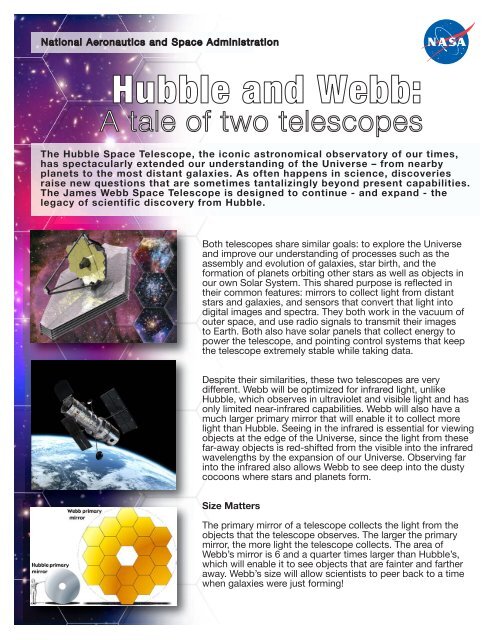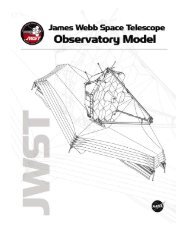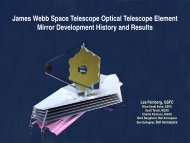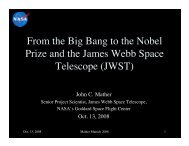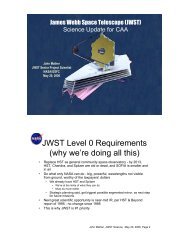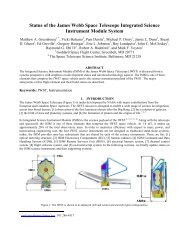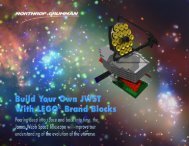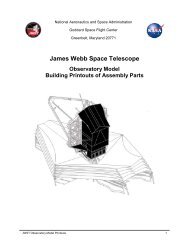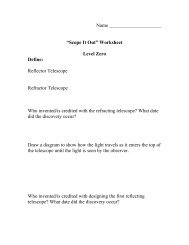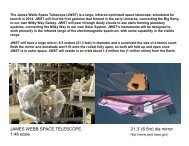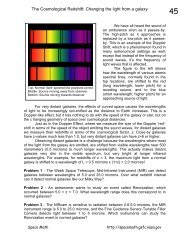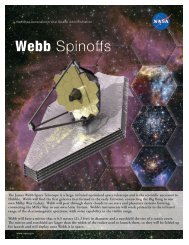1.4 MB .pdf - James Webb Space Telescope - NASA
1.4 MB .pdf - James Webb Space Telescope - NASA
1.4 MB .pdf - James Webb Space Telescope - NASA
Create successful ePaper yourself
Turn your PDF publications into a flip-book with our unique Google optimized e-Paper software.
National Aeronautics and <strong>Space</strong> AdministrationHubble and <strong>Webb</strong>:A tale of two telescopesThe Hubble <strong>Space</strong> <strong>Telescope</strong>, the iconic astronomical observatory of our times,has spectacularly extended our understanding of the Universe – from nearbyplanets to the most distant galaxies. As often happens in science, discoveriesraise new questions that are sometimes tantalizingly beyond present capabilities.The <strong>James</strong> <strong>Webb</strong> <strong>Space</strong> <strong>Telescope</strong> is designed to continue - and expand - thelegacy of scientific discovery from Hubble.Both telescopes share similar goals: to explore the Universeand improve our understanding of processes such as theassembly and evolution of galaxies, star birth, and theformation of planets orbiting other stars as well as objects inour own Solar System. This shared purpose is reflected intheir common features: mirrors to collect light from distantstars and galaxies, and sensors that convert that light intodigital images and spectra. They both work in the vacuum ofouter space, and use radio signals to transmit their imagesto Earth. Both also have solar panels that collect energy topower the telescope, and pointing control systems that keepthe telescope extremely stable while taking data.Despite their similarities, these two telescopes are verydifferent. <strong>Webb</strong> will be optimized for infrared light, unlikeHubble, which observes in ultraviolet and visible light and hasonly limited near-infrared capabilities. <strong>Webb</strong> will also have amuch larger primary mirror that will enable it to collect morelight than Hubble. Seeing in the infrared is essential for viewingobjects at the edge of the Universe, since the light from thesefar-away objects is red-shifted from the visible into the infraredwavelengths by the expansion of our Universe. Observing farinto the infrared also allows <strong>Webb</strong> to see deep into the dustycocoons where stars and planets form.Size MattersThe primary mirror of a telescope collects the light from theobjects that the telescope observes. The larger the primarymirror, the more light the telescope collects. The area of<strong>Webb</strong>’s mirror is 6 and a quarter times larger than Hubble’s,which will enable it to see objects that are fainter and fartheraway. <strong>Webb</strong>’s size will allow scientists to peer back to a timewhen galaxies were just forming!
<strong>Webb</strong> is CoolSince all objects (including telescopes) emit infrared light as abyproduct of their temperature, the telescope and itsinstruments must be very cold. <strong>Webb</strong> has a large sunshield thatblocks the light from the Sun, Earth, and Moon, which otherwisewould heat up the telescope and overpower the astronomicalsignals. For this to work, <strong>Webb</strong> must be in an orbit where allthree of these objects are in about the same direction. This isachieved by putting <strong>Webb</strong> in an orbit that is almost a millionmiles (1.5 million km) from Earth at the second Earth-SunLagrange point (L2). This is in contrast to Hubble, which orbitsjust 350 miles (570 km) above the Earth.(not to scale)Technology Improves with the Passage of TimeAll of <strong>Webb</strong>'s mirrors havebeen polished, coated, andcryogenically tested. Here,a set of six are prepped fortests at Marshall <strong>Space</strong>Flight Center.<strong>Webb</strong> employs many technologies developed in the years sinceHubble was launched. These advanced technologies, alsodescribed on our website (www.jwst.nasa.gov), includeultra-lightweight beryllium mirrors; a deployable multilayersunshield; a super-cold mechanical cryocooler; tinymicroshutters used to select specific fields of view; newcommunications networks to transmit and store large quantitiesof data; and ultra-sensitive infrared detectors to recordextremely faint signals. All of these cutting-edge technologiescombine to form a telescope that is about 100 times aspowerful as Hubble.Current Status of the MissionOne of five full-scale <strong>Webb</strong>sunshield membranesundergoes tests at Mantechin Huntsville.<strong>Webb</strong> is in the fabrication, assembly and testing phase of itsdevelopment. All necessary technology developments havebeen completed. Some of the most challenging tasks, such asmaking, polishing, coating, and cryogenically testing theberyllium mirror segments are now finished. The rigorousassembly and test phase is now underway.<strong>Webb</strong> will be launched later this decade on an Ariane 5 rocket.The <strong>James</strong> <strong>Webb</strong> <strong>Space</strong> <strong>Telescope</strong> is an international collaboration between<strong>NASA</strong>, the European <strong>Space</strong> Agency, and the Canadian <strong>Space</strong> Agency.www.nasa.gov


